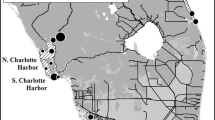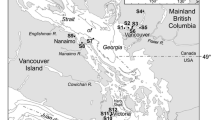Abstract
This article is the second in a series of three that describes the results of a Natural Resource Damage Assessment (NRDA) conducted in the Grand Calumet River and Indiana Harbor Area of Concern (IHAOC). The assessment area is located in northwest Indiana and was divided into nine reaches to facilitate the assessment. This component of the NRDA was undertaken to determine if fish and wildlife resources have been injured due to exposure to contaminants that are associated with discharges of oil or releases of other hazardous substances. To support this assessment, information was compiled on the chemical composition of sediment and tissues; on the toxicity of whole sediments, pore water, and elutriates to fish; on the status of fish communities; and on fish health. The data on each of these indicators were compared to regionally relevant benchmarks to assess the presence and extent of injury to fish and wildlife resources. The results of this assessment indicate that injury to fish and wildlife resources has occurred throughout the assessment area, with up to five distinct lines of evidence demonstrating injury within the various reaches. Based on the frequency of exceedance of the benchmarks for assessing sediment and tissue chemistry data, total polychlorinated biphenyls is the primary bioaccumulative contaminant of concern in the assessment area. It is important to note, however, that this assessment was restricted by the availability of published bioaccumulation-based sediment quality guidelines, tissue residue guidelines, and other benchmarks of sediment quality conditions. The availability of chemistry data for tissues also restricted this assessment in certain reaches of the assessment area. Furthermore, insufficient information was located to facilitate identification of the substances that are causing or substantially contributing to effects on fish (i.e., sediment toxicity, impaired fish health, or impaired fish community structure). Therefore, substances not included on the list of COCs cannot necessarily be considered to be of low priority with respect to sediment injury (e.g., metals, polycyclic aromatic hydrocarbons, alkanes, alkenes, organochlorine pesticides, phthalates, dioxins, and furans, etc.).
Similar content being viewed by others
Author information
Authors and Affiliations
Additional information
Received: 6 February 2001/Accepted: 7 January 2002
Rights and permissions
About this article
Cite this article
MacDonald, D., Ingersoll, C., Smorong, D. et al. Assessment of Injury to Fish and Wildlife Resources in the Grand Calumet River and Indiana Harbor Area of Concern, USA. Arch. Environ. Contam. Toxicol. 43, 130–140 (2002). https://doi.org/10.1007/s00244-001-0053-y
Published:
Issue Date:
DOI: https://doi.org/10.1007/s00244-001-0053-y




